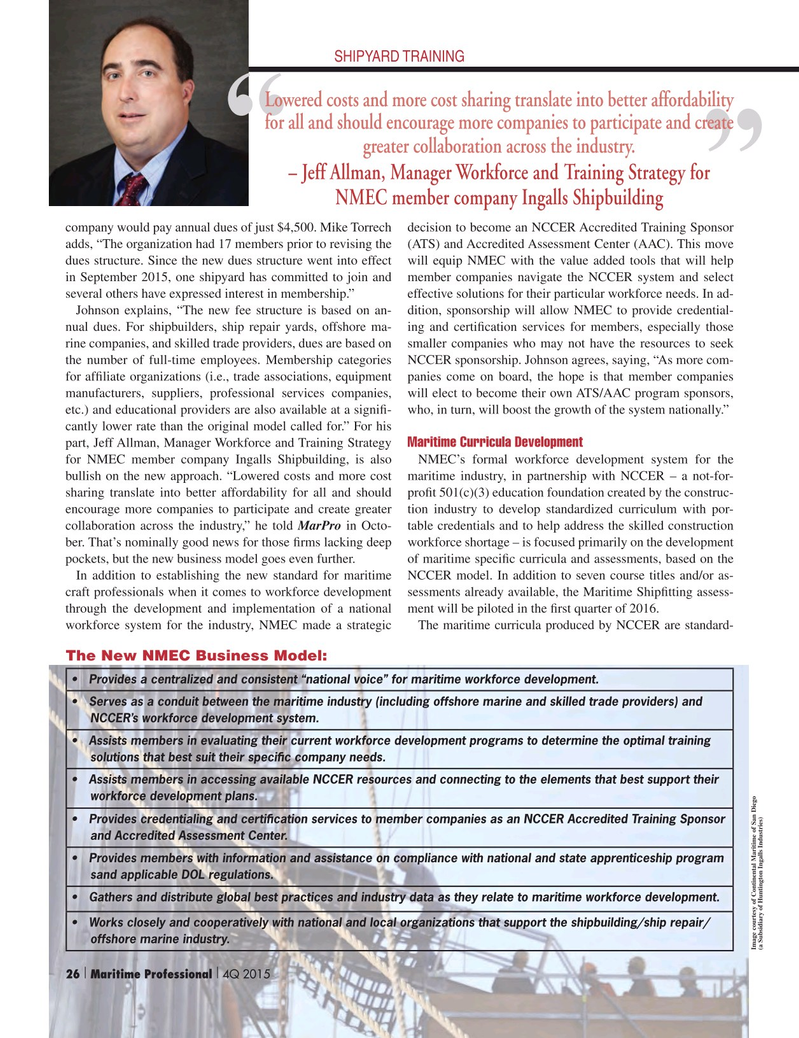
Page 26: of Maritime Logistics Professional Magazine (Q4 2015)
Read this page in Pdf, Flash or Html5 edition of Q4 2015 Maritime Logistics Professional Magazine
SHIPYARD TRAINING
Lowered costs and more cost sharing translate into better affordability for all and should encourage more companies to participate and create greater collaboration across the industry. “ – Jeff Allman, Manager Workforce and Training Strategy for ”
NMEC member company Ingalls Shipbuilding company would pay annual dues of just $4,500. Mike Torrech decision to become an NCCER Accredited Training Sponsor adds, “The organization had 17 members prior to revising the (ATS) and Accredited Assessment Center (AAC). This move dues structure. Since the new dues structure went into effect will equip NMEC with the value added tools that will help in September 2015, one shipyard has committed to join and member companies navigate the NCCER system and select several others have expressed interest in membership.” effective solutions for their particular workforce needs. In ad-
Johnson explains, “The new fee structure is based on an- dition, sponsorship will allow NMEC to provide credential- nual dues. For shipbuilders, ship repair yards, offshore ma- ing and certi? cation services for members, especially those rine companies, and skilled trade providers, dues are based on smaller companies who may not have the resources to seek the number of full-time employees. Membership categories NCCER sponsorship. Johnson agrees, saying, “As more com- for af? liate organizations (i.e., trade associations, equipment panies come on board, the hope is that member companies manufacturers, suppliers, professional services companies, will elect to become their own ATS/AAC program sponsors, etc.) and educational providers are also available at a signi? - who, in turn, will boost the growth of the system nationally.” cantly lower rate than the original model called for.” For his
Maritime Curricula Development part, Jeff Allman, Manager Workforce and Training Strategy for NMEC member company Ingalls Shipbuilding, is also NMEC’s formal workforce development system for the bullish on the new approach. “Lowered costs and more cost maritime industry, in partnership with NCCER – a not-for- sharing translate into better affordability for all and should pro? t 501(c)(3) education foundation created by the construc- encourage more companies to participate and create greater tion industry to develop standardized curriculum with por- collaboration across the industry,” he told MarPro in Octo- table credentials and to help address the skilled construction ber. That’s nominally good news for those ? rms lacking deep workforce shortage – is focused primarily on the development pockets, but the new business model goes even further. of maritime speci? c curricula and assessments, based on the
In addition to establishing the new standard for maritime NCCER model. In addition to seven course titles and/or as- craft professionals when it comes to workforce development sessments already available, the Maritime Ship? tting assess- through the development and implementation of a national ment will be piloted in the ? rst quarter of 2016.
workforce system for the industry, NMEC made a strategic The maritime curricula produced by NCCER are standard-
The New NMEC Business Model: • Provides a centralized and consistent “national voice” for maritime workforce development.
• Serves as a conduit between the maritime industry (including offshore marine and skilled trade providers) and NCCER’s workforce development system.
• Assists members in evaluating their current workforce development programs to determine the optimal training solutions that best suit their speci? c company needs.
• Assists members in accessing available NCCER resources and connecting to the elements that best support their workforce development plans.
• Provides credentialing and certi? cation services to member companies as an NCCER Accredited Training Sponsor and Accredited Assessment Center.
• Provides members with information and assistance on compliance with national and state apprenticeship program sand applicable DOL regulations.
• Gathers and distribute global best practices and industry data as they relate to maritime workforce development.
• Works closely and cooperatively with national and local organizations that support the shipbuilding/ship repair/ offshore marine industry.
Image courtesy of Continental Maritime of San Diego (a Subsidiary of Huntington Ingalls Industries) 26 Maritime Professional 4Q 2015| | 18-33 Q4 MP2015.indd 26 11/18/2015 10:09:57 AM

 25
25

 27
27
